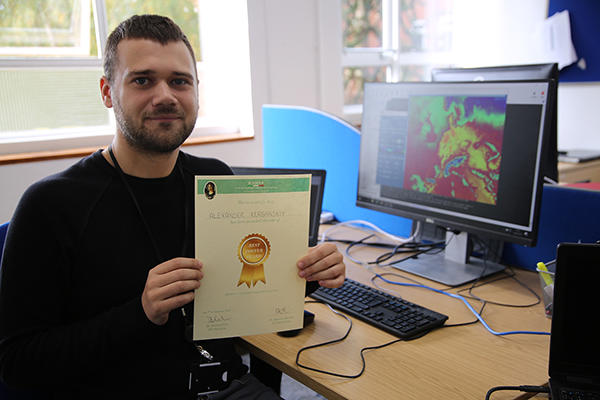University of Worcester Academic Wins Poster Award at International Conference
Wednesday, 17 October 2018
A University of Worcester researcher's work on pollen has been recognised at a major international aerobiology conference.

Dr Alexander Kurganskiy, a post-doctoral researcher, was judged to have one of the top four best posters out of 63 entries at the International Congress on Aerobiology.
He is part of the University's National Pollen and Aerobiology Research Unit team involved in a major piece of research looking at different species of grass pollen around the UK.
"I never expected this award, I was really amazed," he said.
"When I think about it now though, I really feel that we're doing great things in the right way and, since it has been approved by the international aerobiological community, I really believe that we can make a breakthrough in our area. This gives me confidence that it is a very promising and important study. I think the reason that it was picked is because it's such a novel idea and no-one has done it before."
The conference, in Parma, Italy, organised by the International Association for Aerobiology, takes place every four years and attracts 250 scientists from around the world involved in the study of airborne organisms and biological materials.
Dr Kurganskiy, who initially studied in Russia, came to the University of Worcester last year from the University of Copenhagen, where he completed his PhD in geophysics.
His poster detailed research he is leading which focuses on developing a model to establish how much pollen is produced locally and how much is borne on the air.
He had to explain his research in detail to conference attendees and aerobiology experts judging the posters.
Dr Kurganskiy works within the ambitious PollerGEN project, which has received £1.2m funding from NERC (National Environmental Research Council) to revolutionise pollen forecasting, by helping scientists predict what types of grass will be prominent at different points in the season, so they can advise the public. The University of Worcester is a key partner in this research, working to create a model of behaviour using DNA analysis of grass pollen species in different UK locations.
Dr Kurganskiy said: "It's a computer based model and we try to describe behaviour of different types of species of grass " when they start flowering, how much pollen they emit to the atmosphere, how far it's transported from one location to another by wind and how it's deposited back to the ground by rain.
"We do it for the UK for different locations, for different years and seasons.
"For different types of grass people have different symptoms. The broad aim of this is to have a forecasting model, which can be based on all these findings, that can produce concentrations of grass pollen at a species level for people who suffer.
"We're trying to find something that no-one could find before and then put it together. We hope it's going to be a significant contribution."